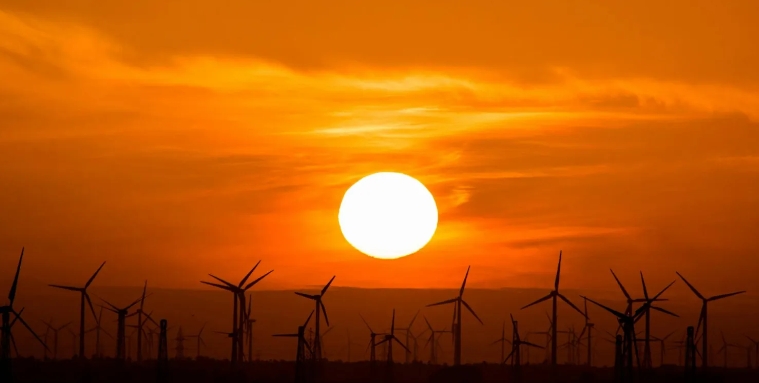
Solar and wind now make up more than 20% of total US electrical generating capacity, according to new data from the Federal Energy Regulatory Commission (FERC).
The renewable energy mix – biomass, geothermal, hydropower, solar, and wind – is now nearly 30% of total US electrical generating capacity.
In FERC’s latest monthly “Energy Infrastructure Update” (with data through May 31, 2024), which was reviewed by the SUN DAY Campaign, for the first five months of 2024, 10,669 MW of solar and 2,095 MW of wind came online, respectively. Combined with 212 MW of hydropower and 3 MW of biomass, renewables year-to-date (YTD) were 89.91% of capacity added, not including the 1,100 MW Vogtle-4 nuclear reactor in Georgia. On the fossil fuel front, 348 MW of gas and 5 MW of oil came online.
Renewables accounted for 94.23% of all new generating capacity added during the month of May.
Solar installation is booming in 2024. New solar capacity added from January through May was more than double the solar capacity (4,885 MW) added year-over-year. YTD, solar accounted for 73.91% of all new generation placed into service in the first five months of 2024.
New wind capacity YTD was 14.51%, which accounted for most of the balance, but that was slightly less year-over-year (The same time frame in 2023 saw 2,760 MW of wind brought online.)
Solar has now been the largest source of new generating capacity for nine months straight, from September 2023 to May 2024. For seven of those nine months, wind was No 2.
In May alone, solar comprised 78.93% of all new capacity added, followed by wind (8.69%).
Solar + wind = 20.55% of US generating capacity. Just solar and wind combined now make up more than one-fifth of the US’s total available installed utility-scale generating capacity.
But one-third or more of US solar capacity is in the form of small-scale – e.g., rooftop – systems that isn’t reflected in FERC’s data. Including that additional solar capacity would bring the share provided by solar + wind closer to 25% of the US total.
Solar is No 4 … The latest capacity additions have brought solar’s share of total available installed utility-scale generating capacity up to 8.78%, further expanding its lead over hydropower (7.83%).
Installed utility-scale solar has now moved into fourth place behind natural gas (43.38%), coal (15.79%), and wind (11.77%) for its share of generating capacity after having recently surpassed nuclear (8.05%).
With the inclusion of biomass (1.12%) and geothermal (0.32%), renewables now claim a 29.82% share of total US utility-scale generating capacity.
… and rising. FERC reports that net “high probability” additions of solar between June 2024 and May 2027 total 89,852 MW – that’s almost four times the forecast net “high probability” additions for wind (23,449 MW), the second fastest growing resource.
FERC also foresees growth for hydropower (558 MW), geothermal (400 MW), and biomass (94 MW), and no new nuclear capacity in FERC’s three-year forecast.
However, coal, natural gas, and oil are projected to shrink by 18,386 MW, 2,785 MW, and 1,269 MW, respectively.
If FERC’s current “high probability” additions materialize, by June 1, 2027, solar will account for 14.65% of the US’s installed utility-scale generating capacity, putting it at second place, behind only natural gas. (Wind is forecast to be at 12.68% and coal at 13.42%.)
Meanwhile, the mix of all renewables would account for 36.10% of total available installed utility-scale generating capacity – nipping at the heels of natural gas (40.30%) – with solar and wind constituting more than three-quarters of the installed renewable energy capacity.
Renewables could exceed natural gas within three years. As said earlier, FERC’s data do not account for the capacity of small-scale solar. If that’s factored in, within three years, total US solar capacity (small-scale + utility-scale) would likely approach – and possibly surpass – 300 gigawatts (GW). In turn, the mix of all renewables would then exceed 40% of total installed capacity while natural gas’s share would drop to about 37%.
Moreover, FERC reports that there may actually be as much as 211,968 MW of net new solar additions in the current three-year pipeline in addition to 70,433 MW of new wind and 7,646 MW of new hydropower. Thus, renewables’ share could be even greater by late spring 2027.
“Step-by-step, installed solar capacity is surpassing all other energy sources,” noted the SUN DAY Campaign’s executive director Ken Bossong. “It has now advanced to fourth place and should be in second within a few years, with wind not far behind.”







